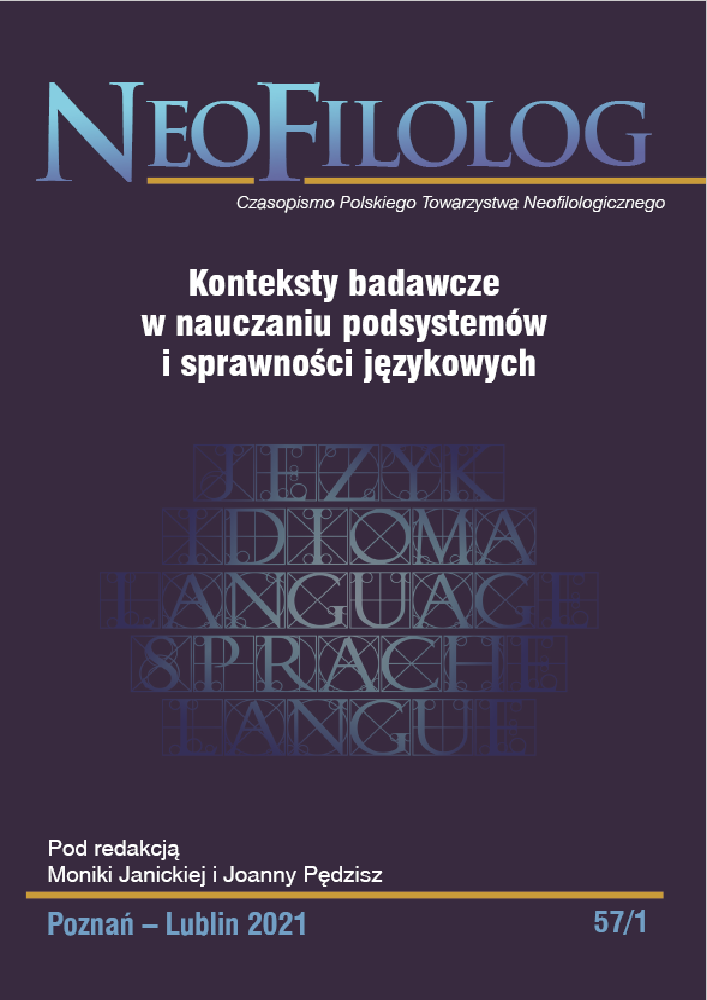Abstract
In today's world interactions between language learners take place not only in a direct form but also online. Online communication requires adequate forms of teaching, one of which can be learning through virtual exchanges. This article shows how this form of learning allows the use of skills characteristic of online interactions defined in the CEFR Companion Volume. The research herein presented is based on data collected during a Polish-Italian virtual exchange. The quantitative and qualitative analysis of A1 level Italian students' statements gathered during the project showed that participation in the virtual exchange was an opportunity for learners to use various skills related to online conversation and discussion defined in the CERF Companion Volume. The results also show that the number of statements created by the learners was significantly higher than the minimum necessary to complete the assigned tasks. Furthermore, the students demonstrated many online interaction skills assigned to the A2 level, thus exceeding the level of their Italian language proficiency. On this basis, it can be concluded that virtual exchanges are an engaging form of learning for students, even at the beginner level, which allows them to realize their potential for communicating in the target language with the use of online interaction skills.
References
Belz J. A. (2003), From the Special Issue Editor. „Language Learning & Technology”, nr 7(2), s. 2–5. Online: http://dx.doi.org/10125/25193 [DW 08.09.2021].
Bérešová J., Micallef A. (2020), Online Interaction Descriptors: A Tool for the Development of Tasks for Language Competences and Language Use. „Journal of Language and Cultural Education”, nr 8(3), s. 60–74. Online: https://sciendo.com/pdf/10.2478/jolace-2020-0020 [DW 08.09.2021].
Cinganotto L. (2019), Online Interaction in Teaching and Learning a Foreign Language: an Italian Pilot Project on the Companion Volume to the CEFR. „Journal of e-Learning and Knowledge Society”, nr 15(1), s. 135–151. Online: https://www.je-lks.org/ojs/index.php/Je-LKS_EN/article/view/1618/1040 [DW 08.09.2021].
Chun D. M. (2011), Developing Intercultural Communicative Competence through Online Exchanges. „CALICO Journal”, nr 28(2), s. 392–419. Online: https://www.jstor.org/stable/calicojournal.28.2.392?seq=1#metadata_info_tab_contents [DW 08.09.2021].
Common European Framework of Reference for Languages: Learning, Teaching, Assessment. Companion Volume with New Descriptors (2018). Strasburg: Rada Europy. Online: https://rm.coe.int/cefr-companion-volume-with-new-descriptors-2018/1680787989 [DW 08.09.2021].
Common European Framework of Reference for Languages: Learning, Teaching, Assessment. Companion Volume with New Descriptors (2020). Strasburg: Rada Europy. Online: https://rm.coe.int/common-european-framework-of-reference-for-languages-learning-teaching/16809ea0d4 [DW 08.09.2021].
Cunningham J., Vyatkina, N. (2012), Telecollaboration for Professional Purposes: Towards Developing a Formal Register in the Foreign Language Classroom. „The Canadian Modern Language Review”, nr 68, s. 422–450. Online: https://www.academia.edu/5020996/Telecollaboration_for_Professional_Purposes_Towards_Developing_a_Formal_Register_in_the_Foreign_Language_Classroom [DW 08.09.2021].
Europejski system opisu kształcenia językowego: uczenie się, nauczanie, ocenianie. Warszawa: Wydawnictwa Centralnego Ośrodka Doskonalenia Nauczycieli, 2003. Online: https://www.ore.edu.pl/wp-content/uploads/attachments/ESOKJ_Europejski-System-Opisu.pdf [DW 08.09.2021].
Dunne B. (2014), Reflecting on the Japan-Chile Task-Based Telecollaboration Project for Beginner-Level Learners. „TESL Canada Journal/Revue TESL du Canada”, nr 31(8), s. 175-186. Online: https://teslcanadajournal.ca/index.php/tesl/article/download/1193/1013/ [DW 08.09.2021].
Fuchs C. (2019), Critical Incidents and Cultures-of-use in a Hong Kong-Germany Telecollaboration. „Language Learning & Technology”, nr 23(3), 74–97. Online: https://www.lltjournal.org/item/3122 [DW 08.09.2021].
Gadomska A. (2019), Applying the CEFR Descriptors for Online Interaction and Mediation for the Design of Moodle Based TEFL Materials. „E-learning”, nr 11, s. 473–481. Online: https://us.edu.pl/wydzial/wsne/wp-content/uploads/sites/20/Nieprzypisane/29-APPLYING-THE-CEFR-DESCRIPTORS...-1.pdf [DW 08.09.2021].
Guth S., Helm F. (2012), Developing Multiliteracies in ELT Through Telecollaboration. „ELT Journal”, nr 66(1), s. 42–51. Online: https://www.researchgate.net/publication/273370405_Developing_multiliteracies_in_ELT_through_telecollaboration [DW 08.09.2021].
Helm F. (2014), Developing Digital Literacies Through Virtual Exchange. „eLearning Papers”, nr 38, s. 43–52. Online: https://www.academia.edu/12657065/Developing_digital_literacies_through_virtual_exchange [DW 08.09.2021].
Janowska I. (2015), Europejski system opisu kształcenia językowego – treści i funkcje dokumentu, (w:) Lipińska E., Seretny A. (red.), Umiejętność rozumienia i tworzenia tekstów w świetle „Standardów wymagań egzaminacyjnych” oraz „Europejskiego systemu opisu kształcenia językowego”: monografia zbiorowa. Kraków: Księgarnia Akademicka, s. 17–30. Online: https://ruj.uj.edu.pl/xmlui/bitstream/handle/item/16141/janowska_europejski_system_opisu_ksztalcenia_jezykowego_2015.pdf?sequence=1&isAllowed=y [DW 08.09.2021].
Janowska I. (2020), Mniej niż A1…, czyli o kompetencjach użytkownika języka na poziomie pre-A1, (w:) Dąbrowski A., Kucharczyk R., Leńko-Szymańska A., Sujecka-Zając J. (red.), Kompetencje XXI wieku: certyfikacja biegłości językowej = Competences of the 21st Century: Certification of Language Proficiency. Warszawa: Wydawnictwa Uniwersytetu Warszawskiego, s. 57–79.
Langé G., Cinganotto L., Benedetti F. (2020), Interazione online: una sperimentazione italiana. „Italiano LinguaDue”, nr 1, s. 603–612. Online: https://riviste.unimi.it/index.php/promoitals/article/view/13948/13090 [DW 08.09.2021].
Lewis T., O’Dowd R. (2016), Introduction to Online Intercultural Exchange and This Volume, (w:) Lewis T., O’Dowd R. (red.), Online Intercultural Exchange. Policy, Pedagogy, Practice. Abingdon: Routledge, s. 3–20.
North B., Piccardo E. (2019), Developing New CEFR Descriptor Scales and Expanding the Existing Ones: Constructs, Approaches and Methodologies. „Zeitschrift Für Fremdsprachenforschung”, nr 30(2), s. 143–161. Online: https://www.dgff.de/assets/Uploads/ZFF-2-2019-01-North-Piccardo.pdf [DW 08.09.2021].
Schenker T. (2012), Intercultural Competence and Cultural Learning Though Telecollaboration. „CALICO Journal”, nr 29, s. 449–470. DOI: 10.11139/cj.29.3.449-470. Online: https://journals.equinoxpub.com/CALICO/article/download/23720/19725 [DW 08.09.2021].
License
Copyright (c) 2021 Anna Pieczka

This work is licensed under a Creative Commons Attribution-NoDerivatives 4.0 International License.
Authors
Authors of texts accepted for publication in Neofilolog are required to complete, sign and return to the Editorial team’s office the Agreement for granting a royalty-free license to works with a commitment to grant a CC sub-license.
Under the agreement, the authors of the texts published in Neofilolog grant Adam Mickiewicz University in Poznań a non-exclusive, royalty-free license and authorize the use of Attribution-NoDerivatives 4.0 International (CC BY-ND 4.0) Creative Commons sub-license.
The authors retain the right to the free disposal of the work.
Users
Interested Internet users are entitled to use works that have been published in Neofilolog since 2017, under the following conditions:
▪ attribution – obligation to provide, together with the distributed work, information about the authorship, title, source (link to the original work, DOI) and the license itself.
▪ no derivatives – the work must be preserved in its original form. Without the author's consent, it is not possible to distribute the modified work in the form of translations, publications, etc.
Copyrights are reserved for all texts published since 2017.
Miscellaneous
Adam Mickiewicz University in Poznań retains the property right as a whole (layout, graphic form, title, cover design, logo etc.).

